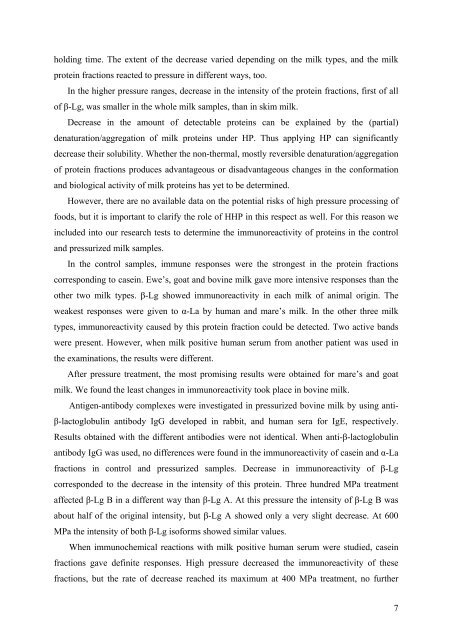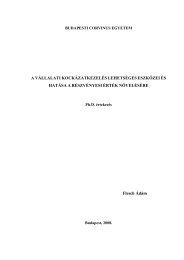Klára Pásztor-Huszár - Budapesti Corvinus Egyetem
Klára Pásztor-Huszár - Budapesti Corvinus Egyetem
Klára Pásztor-Huszár - Budapesti Corvinus Egyetem
You also want an ePaper? Increase the reach of your titles
YUMPU automatically turns print PDFs into web optimized ePapers that Google loves.
holding time. The extent of the decrease varied depending on the milk types, and the milk<br />
protein fractions reacted to pressure in different ways, too.<br />
In the higher pressure ranges, decrease in the intensity of the protein fractions, first of all<br />
of β-Lg, was smaller in the whole milk samples, than in skim milk.<br />
Decrease in the amount of detectable proteins can be explained by the (partial)<br />
denaturation/aggregation of milk proteins under HP. Thus applying HP can significantly<br />
decrease their solubility. Whether the non-thermal, mostly reversible denaturation/aggregation<br />
of protein fractions produces advantageous or disadvantageous changes in the conformation<br />
and biological activity of milk proteins has yet to be determined.<br />
However, there are no available data on the potential risks of high pressure processing of<br />
foods, but it is important to clarify the role of HHP in this respect as well. For this reason we<br />
included into our research tests to determine the immunoreactivity of proteins in the control<br />
and pressurized milk samples.<br />
In the control samples, immune responses were the strongest in the protein fractions<br />
corresponding to casein. Ewe’s, goat and bovine milk gave more intensive responses than the<br />
other two milk types. β-Lg showed immunoreactivity in each milk of animal origin. The<br />
weakest responses were given to α-La by human and mare’s milk. In the other three milk<br />
types, immunoreactivity caused by this protein fraction could be detected. Two active bands<br />
were present. However, when milk positive human serum from another patient was used in<br />
the examinations, the results were different.<br />
After pressure treatment, the most promising results were obtained for mare’s and goat<br />
milk. We found the least changes in immunoreactivity took place in bovine milk.<br />
Antigen-antibody complexes were investigated in pressurized bovine milk by using antiβ-lactoglobulin<br />
antibody IgG developed in rabbit, and human sera for IgE, respectively.<br />
Results obtained with the different antibodies were not identical. When anti-β-lactoglobulin<br />
antibody IgG was used, no differences were found in the immunoreactivity of casein and α-La<br />
fractions in control and pressurized samples. Decrease in immunoreactivity of β-Lg<br />
corresponded to the decrease in the intensity of this protein. Three hundred MPa treatment<br />
affected β-Lg B in a different way than β-Lg A. At this pressure the intensity of β-Lg B was<br />
about half of the original intensity, but β-Lg A showed only a very slight decrease. At 600<br />
MPa the intensity of both β-Lg isoforms showed similar values.<br />
When immunochemical reactions with milk positive human serum were studied, casein<br />
fractions gave definite responses. High pressure decreased the immunoreactivity of these<br />
fractions, but the rate of decrease reached its maximum at 400 MPa treatment, no further<br />
7
















